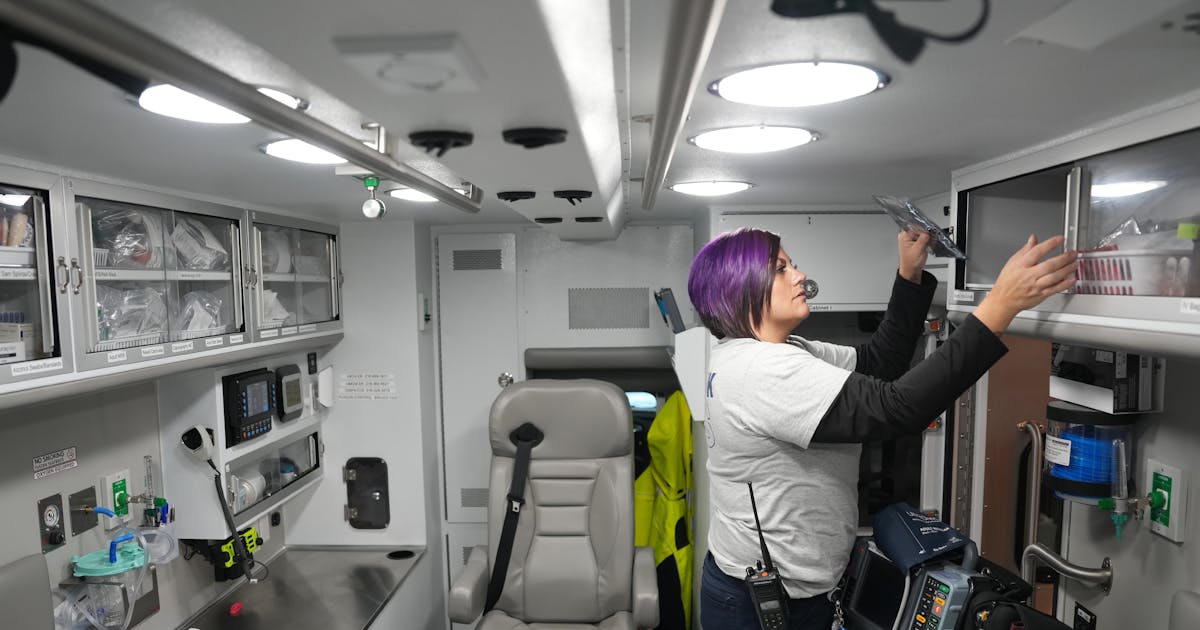
DULUTH — A 650-square-mile region carved out on the western Iron Range is in danger of losing its ambulance service.
The city of Nashwauk has handled operations for its own 1,000-resident town and seven other townships or cities, some at least 30 minutes away, since 2000. But its reimbursements from Medicare and Medicaid only cover a portion of each run, Mayor Calvin Saari said, putting the city in debt and raising the eventual threat of bankruptcy.
Ending service would be a tragedy for our community, Saari said. "So we're looking for some way to keep things afloat."
It's something ambulance services across the state are struggling to do, as operational costs — but not reimbursement rates — escalate. It's especially problematic in greater Minnesota, where lower call volumes and a lack of volunteers mean less revenue than in metro areas.
"It's just not a sustainable business model," said Erik Simonson, a lobbyist for the Coalition of Greater Minnesota Cities.
Nashwauk's budget is about $1.8 million. Through mid-November, the city had lost $120,000 to uncovered ambulance costs in 2023.
The city is considering several options, from a private company taking it over to creating a tax district with the other cities and townships who use the service, but each option has drawbacks, he said.
The last resort is returning the license to the state, which would divide up the service area to Grand Rapids to the west and Hibbing to the east.
That division would lengthen ambulance travel time, with some routes taking as long as 90 minutes. That's something the Nashwauk workers can't even fathom, said Leann Stoll, a union representative for AFSCME Council 65, which represents Nashwauk's seven emergency service workers.
The ambulance workers in Grand Rapids and Hibbing are strapped, she said, and would struggle if their service area grew.
"We have to make sacrifices and decisions over what is most beneficial," Stoll said. "And emergency health services really should be close to the top of that list."
Duluth-based Essentia Health runs seven rural ambulance services in northern Minnesota, including the Iron Range's Buhl. Nashwauk officials approached the health system about taking over service, but it declined, said Joe Newton, director of emergency services for Essentia Health.
"We would face the same challenges in that area as every ambulance service does," Newton said, including workforce shortages and the payment model for pre-hospital emergency care. "It's unsustainable to provide the care that citizens deserve and in no way covers the cost of providing those services."
Saari said it costs the city about $1,600 per ambulance run, and for those patients who have Medicaid or Medicare — more than 70% of patients — the city is reimbursed $470. Some have supplemental insurance, but many don't, he said.
The Minnesota Emergency Medical Services Regulatory Board released a financial evaluation of the state's ground ambulance industry last month. It found that ambulance services statewide reported $1.2 billion in insurance billables in 2022 but received about $450 million in insurance payments. More than 70% reported financial losses.
"The report underscores the harsh reality that ambulance services often fail to recover the actual costs of providing their services," the evaluation says.
Simonson said that is deeply felt in rural Minnesota. The coalition's priority in the next legislative session is one-time money for ambulance providers, followed by reform efforts, he said, noting previous attempts by the Legislature to provide aid had stalled.
Nashwauk officials have asked for proposals from potential operators interested in its license, but the city has only received a few phone calls and no proposals, Saari said.
It also could consider fewer employees or reverting back to its former paid on-call model of operations, which limits availability because of scheduling conflicts with other jobs. The city is discussing the formation of a tax district with the other entities in the service area to share the costs now borne only by Nashwauk. City officials will meet with leaders of those communities in the coming days.
If a tax district model were adopted, Nashwauk would lose jurisdiction over the ambulance service, Saari said, because a joint powers board would be formed to oversee it.
Some residents who spoke at a recent Nashwauk City Council meeting advocated for a tax district, spreading the cost of emergency care across all who benefit from the service. Nashwauk Township resident Rick Hipsag said he doubts many would protest higher taxes for something that all residents could potentially need.
The Nashwauk ambulance service helped save his daughter's leg in 2019, after a horrific car accident that took the life of his 2-year-old grandson.
Not only did his family know who the workers were — which gave them comfort on that traumatic day — the response time was mere minutes, crucial because his daughter needed extensive care in Duluth nearly two hours away. Longer wait times would be hard on first responders trying to keep people alive until an ambulance arrives, he said.
"If you have to wait for up to an hour and a half, if you're a heart attack victim — you'd be losing lots of lives," Hipsag said. "You can't put a dollar amount on that."
"lose" - Google News
December 03, 2023 at 08:01PM
https://ift.tt/m2at6Ks
An Iron Range region could lose ambulance service - Star Tribune
"lose" - Google News
https://ift.tt/sMxKHvG https://ift.tt/hGe3Wwy
Bagikan Berita Ini














0 Response to "An Iron Range region could lose ambulance service - Star Tribune"
Post a Comment